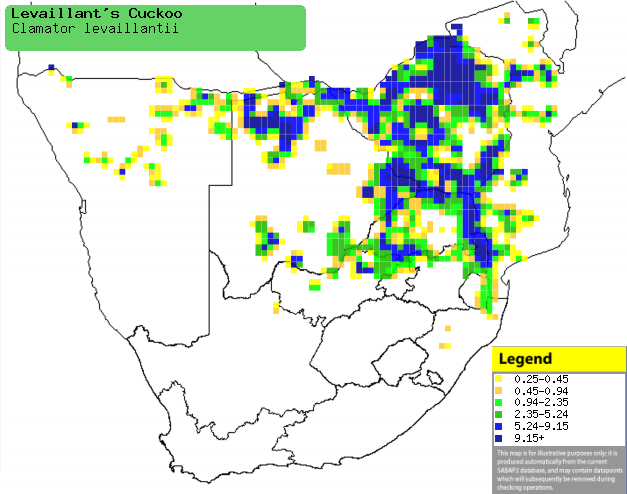|
Clamator levaillantii (Levaillant's
cuckoo, Striped cuckoo)
Gestreepte nuwejaarsvoël [Afrikaans]; Tihunyi
(also applied to Jacobin cuckoo) [Tsonga]; Levaillant-koekoek [Dutch];
Coucou de Levaillant [French]; Kapkuckuck [German]; Cuco da Cafraria
[Portuguese]
Life
> Eukaryotes >
Opisthokonta
> Metazoa (animals) >
Bilateria >
Deuterostomia > Chordata >
Craniata > Vertebrata (vertebrates) > Gnathostomata (jawed
vertebrates) > Teleostomi (teleost fish) > Osteichthyes (bony fish) > Class:
Sarcopterygii (lobe-finned
fish) > Stegocephalia (terrestrial
vertebrates) > Tetrapoda
(four-legged vertebrates) > Reptiliomorpha > Amniota >
Reptilia (reptiles) >
Romeriida > Diapsida > Archosauromorpha > Archosauria >
Dinosauria
(dinosaurs) > Saurischia > Theropoda (bipedal predatory dinosaurs) >
Coelurosauria > Maniraptora > Aves
(birds) > Order: Cuculiformes
> Family: Cuculidae
The Levaillant's cuckoo occurs in huge areas of sub-Saharan
Africa, preferring Acacia, miombo and broad-leaved Burkea woodland. It is
extremely secretive and hard to find, foraging in thick undergrowth. It almost
exclusively parasitizes babblers, for
reasons not understood. Egg-laying is an elaborate process, with the male
distracting the host birds, while the female sneaks into the nest to lay its
egg. Unlike many other cuckoos, the chick does
not kill the host nestlings, in fact they often co-exist quite peacefully. The
chick stays in the nest for about 9-10 days, becoming fully independent 3-5
weeks later.
Distribution and habitat
Occurs across much of sub-Saharan
Africa, excluding arid areas. In southern Africa it is uncommon in northern
Namibia, northern and southern Botswana, Zimbabwe, Mozambique, Swaziland and
north-eastern South Africa. It
is secretive and elusive, generally preferring Acacia, miombo (Brachystegia)
and broad-leaved Burkea woodland.
|
 |
|
Distribution of Levaillant's cuckoo in southern Africa,
based on statistical smoothing of the records from first SA Bird Atlas
Project (©
Animal Demography unit, University of
Cape Town; smoothing by Birgit Erni and Francesca Little). Colours range
from dark blue (most common) through to yellow (least common).
See here for the latest distribution
from the SABAP2. |
Call
Movements and migrations
Intra-African breeding
migrant, arriving in southern Africa from October-November, going through its
full breeding cycle before departing around March-April.
Food
Eats mainly caterpillars, occasionally supplemented with other insects or fruit. The following food
items have been recorded in its diet:
- Insects
- Plants
- berries
- young tree shoots
Breeding
- It is a brood parasite, meaning that it lays its eggs
in other birds nests. The host, thinking that the egg is its own, incubates
the egg and cares for the chick. The following bird species have been
recorded to be parasitized by the Levaillant's cuckoo:
- Egg-laying season is from
October-May.
- It is difficult for the female to lay an
egg in the host nest, as they usually attack cuckoos
vigorously. In order to distract them, both sexes fly around
acrobatically, provoking a group attack from the hosts. The male takes the
brunt of the attack, while the female endeavours to lay an egg in the nest,
after which both sexes retreat, with the host birds hot in pursuit. This
process can last hours, sometimes even 2-3 days!
- The chick hatches after an
incubation period of about 11-13 days, remaining in the nest for around 9-10
days. Unlike many other cuckoos, the chick does not kill the host nestlings,
in fact they often co-exist quite peacefully. It learns to fly soon after leaving, becoming fully independent at
about 29-42 days old.
Threats
Not threatened.
References
-
Hockey PAR, Dean WRJ and Ryan PG (eds) 2005. Roberts
- Birds of southern Africa, VIIth ed. The Trustees of the John Voelcker
Bird Book Fund, Cape Town.
|
